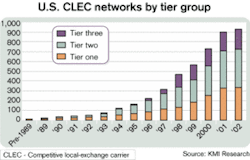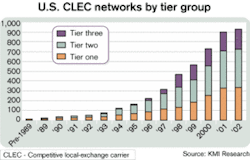CLEC build strategy changes focus
The competitive-local-exchange-carrier (CLEC) market in the United States has continued to show signs of growth, despite retrenchments in other areas of telecommunications services, reveals a new study from KMI Research (Providence). "CLECs have actually increased their access lines in both absolute numbers and in overall share," says KMI analyst Michael Arden.
U.S.-based CLECs have seen their share of financial problems. Annual CLEC fiber deployment fell 80% during 2001-02. More than one-quarter of the CLECs profiled in the report have gone into bankruptcy protection in the past 18 months, and another large portion of those companies have been merged into other entities. Total CLEC network growth has flattened as a result.KMI analysts predict a continued decline in annual fiber-km deployments by CLECs, falling to a level below 450,000-km by 2007. That will mean a 3% CAGR for cumulative CLEC fiber-km during 2002-07.
The future of CLEC deployments appears to be in building extensions to existing networks, claims the report. All tier one cities have CLEC networks, and all but two of the tier two cities have at least one CLEC network. Because the business proposition for CLECs has not been as strong in the tier three cities, 46% have no CLEC penetration. While many tier three cities provide an untapped market for CLEC networks, they do not necessarily have the business-center density and residential customer base that would make such a move realistic. As a result, many CLECs will focus on expanding the reach of their current networks through spurs and new building connections.
For more details on the report, "U.S. CLECs: Market Developments and Fiberoptic Systems Deployment," visit the company's Website, www.kmiresearch.com.

